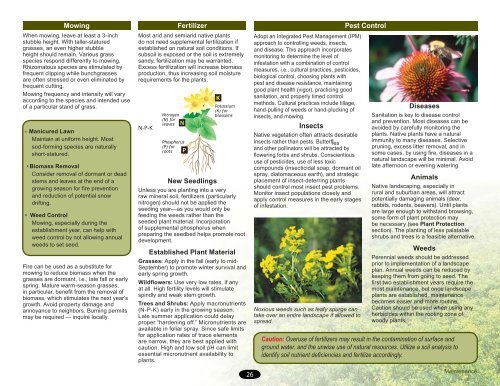Living Landscapes in South Dakota - Plant Materials Program - US ...
Living Landscapes in South Dakota - Plant Materials Program - US ...
Living Landscapes in South Dakota - Plant Materials Program - US ...
Create successful ePaper yourself
Turn your PDF publications into a flip-book with our unique Google optimized e-Paper software.
Mow<strong>in</strong>g<br />
When mow<strong>in</strong>g, leave at least a 3-<strong>in</strong>ch<br />
stubble height. With taller-statured<br />
grasses, an even higher stubble<br />
height should rema<strong>in</strong>. Various grass<br />
species respond differently to mow<strong>in</strong>g.<br />
Rhizomatous species are stimulated by<br />
frequent clipp<strong>in</strong>g while bunchgrasses<br />
are often stressed or even elim<strong>in</strong>ated by<br />
frequent cutt<strong>in</strong>g.<br />
Mow<strong>in</strong>g frequency and <strong>in</strong>tensity will vary<br />
accord<strong>in</strong>g to the species and <strong>in</strong>tended use<br />
of a particular stand of grass.<br />
• Manicured Lawn<br />
Ma<strong>in</strong>ta<strong>in</strong> at uniform height. Most<br />
sod-form<strong>in</strong>g species are naturally<br />
short-statured.<br />
• Biomass Removal<br />
Consider removal of dormant or dead<br />
stems and leaves at the end of a<br />
grow<strong>in</strong>g season for fi re prevention<br />
and reduction of potential snow<br />
drift<strong>in</strong>g.<br />
• Weed Control<br />
Mow<strong>in</strong>g, especially dur<strong>in</strong>g the<br />
establishment year, can help with<br />
weed control by not allow<strong>in</strong>g annual<br />
weeds to set seed.<br />
Fire can be used as a substitute for<br />
mow<strong>in</strong>g to reduce biomass when the<br />
grasses are dormant, i.e., late fall or early<br />
spr<strong>in</strong>g. Mature warm-season grasses,<br />
<strong>in</strong> particular, benefit from the removal of<br />
biomass, which stimulates the next year’s<br />
growth. Avoid property damage and<br />
annoyance to neighbors. Burn<strong>in</strong>g permits<br />
may be required — <strong>in</strong>quire locally.<br />
Fertilizer<br />
Most arid and semiarid native plants<br />
do not need supplemental fertilization if<br />
established on natural soil conditions. If<br />
subsoil is exposed or the soil is extremely<br />
sandy, fertilization may be warranted.<br />
Excess fertilization will <strong>in</strong>crease biomass<br />
production, thus <strong>in</strong>creas<strong>in</strong>g soil moisture<br />
requirements for the plants.<br />
N-P-K<br />
New Seedl<strong>in</strong>gs<br />
Unless you are plant<strong>in</strong>g <strong>in</strong>to a very<br />
raw m<strong>in</strong>eral soil, fertilizers (particularly<br />
nitrogen) should not be applied the<br />
seed<strong>in</strong>g year—as you would only be<br />
feed<strong>in</strong>g the weeds rather than the<br />
seeded plant material. Incorporation<br />
of supplemental phosphorus when<br />
prepar<strong>in</strong>g the seedbed helps promote root<br />
development.<br />
Established <strong>Plant</strong> Material<br />
Grasses: Apply <strong>in</strong> the fall (early to mid-<br />
September) to promote w<strong>in</strong>ter survival and<br />
early spr<strong>in</strong>g growth.<br />
Wildflowers: Use very low rates, if any<br />
at all. High fertility levels will stimulate<br />
sp<strong>in</strong>dly and weak stem growth.<br />
Trees and Shrubs: Apply macronutrients<br />
(N-P-K) early <strong>in</strong> the grow<strong>in</strong>g season.<br />
Late summer application could delay<br />
proper “harden<strong>in</strong>g off.” Micronutrients are<br />
available <strong>in</strong> foliar spray. S<strong>in</strong>ce safe limits<br />
for application rates of trace elements<br />
are narrow, they are best applied with<br />
caution. High and low soil pH can limit<br />
essential micronutrient availability to<br />
plants.<br />
Adopt an Integrated Pest Management (IPM)<br />
approach to controll<strong>in</strong>g weeds, <strong>in</strong>sects,<br />
and disease. This approach <strong>in</strong>corporates<br />
monitor<strong>in</strong>g to determ<strong>in</strong>e the level of<br />
<strong>in</strong>festation with a comb<strong>in</strong>ation of control<br />
measures, i.e., cultural practices, pesticides,<br />
biological control, choos<strong>in</strong>g plants with<br />
pest and disease resistance, ma<strong>in</strong>ta<strong>in</strong><strong>in</strong>g<br />
good plant health (vigor), practic<strong>in</strong>g good<br />
sanitation, and properly timed control<br />
methods. Cultural practices <strong>in</strong>clude tillage,<br />
hand-pull<strong>in</strong>g of weeds or hand-pluck<strong>in</strong>g of<br />
<strong>in</strong>sects, and mow<strong>in</strong>g.<br />
Insects<br />
Native vegetation often attracts desirable<br />
<strong>in</strong>sects rather than pests. Butterflies<br />
and other poll<strong>in</strong>ators will be attracted by<br />
flower<strong>in</strong>g forbs and shrubs. Conscientious<br />
use of pesticides, use of less toxic<br />
compounds (<strong>in</strong>secticidal soap, dormant oil<br />
spray, diatomaceous earth), and strategic<br />
placement of <strong>in</strong>sect-deterr<strong>in</strong>g plants<br />
should control most <strong>in</strong>sect pest problems.<br />
Monitor <strong>in</strong>sect populations closely and<br />
apply control measures <strong>in</strong> the early stages<br />
of <strong>in</strong>festation.<br />
Noxious weeds such as leafy spurge can<br />
take over an entire landscape if allowed to<br />
spread.<br />
Pest Control<br />
Diseases<br />
Sanitation is key to disease control<br />
and prevention. Most diseases can be<br />
avoided by carefully monitor<strong>in</strong>g the<br />
plants. Native plants have a natural<br />
immunity to many diseases. Selective<br />
prun<strong>in</strong>g, excess litter removal, and <strong>in</strong><br />
some cases, by us<strong>in</strong>g fire, diseases <strong>in</strong> a<br />
natural landscape will be m<strong>in</strong>imal. Avoid<br />
late afternoon or even<strong>in</strong>g water<strong>in</strong>g.<br />
Animals<br />
Native landscap<strong>in</strong>g, especially <strong>in</strong><br />
rural and suburban areas, will attract<br />
potentially damag<strong>in</strong>g animals (deer,<br />
rabbits, rodents, beavers). Until plants<br />
are large enough to withstand brows<strong>in</strong>g,<br />
some form of plant protection may<br />
be necessary (see <strong>Plant</strong> Protection<br />
section). The plant<strong>in</strong>g of less palatable<br />
shrubs and trees is a feasible alternative.<br />
Weeds<br />
Perennial weeds should be addressed<br />
prior to implementation of a landscape<br />
plan. Annual weeds can be reduced by<br />
keep<strong>in</strong>g them from go<strong>in</strong>g to seed. The<br />
first two establishment years require the<br />
most ma<strong>in</strong>tenance, but once landscape<br />
plants are established, ma<strong>in</strong>tenance<br />
becomes easier and more rout<strong>in</strong>e.<br />
Caution should be used when us<strong>in</strong>g any<br />
herbicides with<strong>in</strong> the root<strong>in</strong>g zone of<br />
woody plants.<br />
Caution: Overuse of fertilizers may result <strong>in</strong> the contam<strong>in</strong>ation of surface and<br />
ground water, and the unwise use of natural resources. Utilize a soil analysis to<br />
identify soil nutrient deficiencies and fertilize accord<strong>in</strong>gly.<br />
26<br />
Ma<strong>in</strong>tenance

















